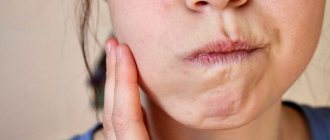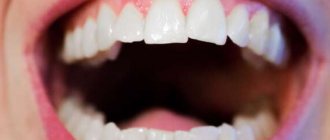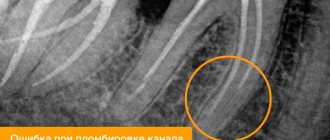After surgical extraction of a tooth and the appearance in the mouth of a natural wound for this situation - a hole, almost everyone has a desire to help the healing process in every possible way, to protect the wound from the proliferation of pathogenic bacteria. After all, more than once in our lives, each of us has heard terrifying stories from relatives and friends about how they suffered and struggled with the inflammatory process that arose after the same operation. In addition, until quite recently, every dental surgeon, after removing a tooth, warned the patient about the need to rinse, and the fact that today most of them are silent about this seems to us, at a minimum, to be unprofessional. We hasten to reassure you - the whole point is only a revaluation of approaches to understanding natural healing processes. Let's look in more detail in which cases rinsing can be beneficial and in which it can be harmful, and how to rinse the mouth after tooth extraction.
Why do you need to rinse your mouth after tooth extraction?
After the tooth extraction procedure, a hole with damaged blood vessels remains. A blood clot forms in it, protecting the wound from infection. New mucous membrane grows under it, and the periosteum heals. If the clot is accidentally removed or washed out, bleeding may resume. The wound will become vulnerable to various infections. For this reason, complications often develop. Therefore, oral care after tooth extraction should be extremely careful.
Rinsing is prescribed to prevent wound infection and the occurrence of purulent-septic complications. They promote rapid healing of the gums and reduce swelling that is possible after surgery. Only a doctor can tell you whether it is necessary and possible to rinse your mouth after tooth extraction. Trying to treat a wound on your own can be harmful.
How long can it take to process?
When removing a tooth, the dentist must treat the wound, remove any remaining pus, and tooth fragments. But it does not stop the bleeding. A dense blood clot forms at that site, which acts as a plug, thereby clogging the wound. It protects it from food, moisture, and those same bacteria.
But until that clot “hardens” completely, no manipulations with the wound can be carried out. Any lotions, compresses, or rinses will cause the blood clot to simply become limp and “fall out” of the wound.
How long does it take for the clot to “freeze”? On average - 24-36 hours. During this period, you should eat with caution, brush your teeth (without running a toothbrush over the wound), avoid hot foods (this even applies to baths or showers) and smoking.
It is possible to treat the area where the diseased tooth was previously located only after 36-48 hours. Moreover, it is better to start with ordinary cotton compresses. When rinsing the mouth, there is a high probability that the blood clot will “come out”.
After tooth extraction, the doctor will definitely tell you what the patient should do afterwards. First of all, it is necessary to focus on his instructions, since he assesses both the patient’s condition and the likelihood of damage to the jaw bone. If necessary, he will prescribe an antibiotic and painkiller, and set a day for a re-examination.
Indications for use of Miramistin
Rinsing is often prescribed in the following cases:
- before extirpation (removal) of the tooth, inflammation (pulpitis, periodontitis) was diagnosed;
- the gums were additionally injured (for example, the gumboil was opened, drainage was installed to remove pus);
- There are sources of infection in the oral cavity (carious teeth, stomatitis, tartar, inflammation of the gums, etc.).
These factors significantly increase the risk of wound infection. You can prevent it by knowing how to rinse your mouth. This disinfects the hole, destroys pathogenic microflora, so the likelihood of developing complications is reduced. The main rule is that rinsing should not be too intense. Additionally, the doctor may prescribe antibacterial and anti-inflammatory non-steroidal drugs.
Rinsing is often useful after wisdom tooth removal, since the procedure is traumatic. Eights grow normally only 20% of the time. In 8 out of 10 patients, wisdom teeth are removed at the eruption stage. Due to the peculiarities of their incorrect placement, the tissues are severely damaged, so the recovery period is delayed. Rinsing allows you to speed it up.
Why is processing important?
Typically, a tooth is removed if it is so damaged that it cannot be restored. That is, both its visible part and the root are damaged, and at the same time it is not possible to install a reinforcing pin for subsequent prosthetic restoration with a crown. This procedure is possible only when the thickness of the root walls is at least 2 millimeters. If it has been severely damaged by caries, then the tooth has to be removed completely.
What is caries? This is rot, consisting of a mixture of bacteria. If even a small part of them gets into the wound left after tooth extraction, a purulent sac will certainly appear there. Moreover, all this can happen even without a pain symptom, because the dental nerve usually dies before this moment.
If the pus subsequently breaks out, it may result in blood poisoning. There are also cases where, due to bacterial infection of the wound after tooth extraction, the rotting process transferred to the jaw bone. As a result, part of it had to be removed.
And in order to prevent the above complications, the wound is treated with antiseptics and anti-inflammatory drugs. Miramistin solution (0.01%) is ideal for this, since it is active against bacteria, fungi, viruses, and at the same time strengthens local immunity and prevents the activation of the inflammatory process.
Composition and release forms of the drug
"Miramistin" is a drug based on benzyldimethyl ammonium chloride. The concentration of the active component is 0.01%. The drug occupies a leading position among antiseptics and has a wide range of applications. Often used in dentistry. Its action is aimed at combating infections of a bacterial, fungal and viral nature. Miramistin also accelerates wound healing. By stimulating phagocytosis, it enhances the local immune response.
The drug is available in different forms. For rinsing, an aqueous or alcohol solution is used. It is transparent, practically odorless and tasteless.
How to rinse your mouth with Miramistin after tooth extraction
In the first 1–2 days after extirpation, any rinsing is prohibited. Otherwise, you can wash the clot out of the well. If an infection gets into it, alveolitis or osteomyelitis will begin. In the first case, the socket becomes inflamed, in the second – the bone. That's why they only do baths. Take one sip (10–15 ml) of liquid at room temperature into your mouth, hold it for 1–2 minutes and spit it out.
Next, you should adhere to the following rules:
- Starting from the 3rd–4th day, you can carry out gentle rinsing. To do this, you need to tilt your head several times from the side of the extracted tooth to the healthy one.
- Baths and rinses are carried out immediately after meals.
- After treating the oral cavity with Miramistin for 1–1.5 hours (optimally up to two), you should refrain from smoking, drinking and eating.
In most cases, patients are prescribed 3-4 rinses per day. The course of treatment is up to a week.
After tooth extraction, patients should also pay special attention to oral care. If you are concerned about whether it is possible to do ordinary hygienic rinses, then you should also avoid them at first. In order to maintain hygiene, patients are recommended to use the same baths. To do this, take warm water into your mouth, hold it a little and spit it out. And so several times until you feel fresh.
My wisdom tooth hurts, what should I do?
According to statistics, it is wisdom teeth that most often cause problems.
Erupted “eights” are quickly affected by caries, and sometimes even remain in the bone tissue and in most cases cause discomfort. So what to do with a wisdom tooth when it hurts, haunting you day and night?
What is known about wisdom teeth?
They got their name because they begin to erupt between the ages of 18 and 30. Scientists consider them to be a vestigial organ that does not bear any functional load when chewing food for years. Therefore, at present, some people do not develop “eights” at all.
Their medical name is third molars. These teeth were originally designed for chewing rough food. This determines their specific structure (large root base, width) and strength.
But this is also the main root cause of painful processes during growth, because the larger the area of the upper edge, the more difficult it is to tear the soft tissues and pass through them. Moreover, the bone tissue has already been formed, so the “eights” need to literally break their way, which leads to the formation of edema, suppuration, tumors and other unpleasant consequences.
Typically, discomfort is caused by recumbent “eights”, which grow horizontally in the jaw. They don't have enough space to erupt and put pressure on neighboring teeth. As a result, the entire dentition shifts. Moreover, recumbent “eights” severely injure the gums, which leads to chronic inflammation.
Signs of wisdom teeth erupting
- Pain in the jaw, radiating to the ears and temples
- Inflammation, swelling and itching of the gums behind the last tooth
- Enlarged lymph nodes
- Temperature increase
- Painful swallowing
- Persistent runny nose
- Difficulty opening your mouth
- Halitosis, that is, bad breath.
The presence and nature of symptoms depends on the individual characteristics of the body. There are cases when a person does not experience discomfort or pain at all when teething: this means that the “eight” is growing correctly and does not interfere with neighboring teeth. But it is still necessary to visit the dentist, since the formation of pathology can occur in a hidden form.
What types of wisdom teeth are there? For “eights” that have difficulty erupting, there are special terms in dentistry - “dystopic” and “retained”.
Dystopic teeth are those that grow incorrectly due to lack of space in the jaw. Usually they are shifted towards the tongue, cheeks or located at an angle. Impacted teeth are unerupted teeth that remain completely in the bone. There may also be a state of semi-retention, when the tooth appears, but cannot fully erupt.
Why do wisdom teeth hurt and gums become inflamed?
Most often, pain occurs due to difficult eruption for several reasons.
- Dystopia. This is a situation where the figure eight grows incorrectly relative to the jaw due to lack of space. Trauma to the buccal mucosa, as well as the development of various bite deformities, can be the consequences of a dystopic tooth if it is not removed in time.
- Retention. This is a pathology in which the wisdom tooth erupts with a delay. In this case, the crown of the tooth can be partially cut through or completely hidden under the gum. Late eruption of the figure eight can negatively affect the patient’s general well-being.
- Pericoronitis. This is an inflammation of the gums that occurs when tooth eruption is difficult or incomplete. The reason for this is the development of infection under the hood of the wisdom tooth - this is the part of the mucous membrane that covers the tooth during eruption. The main symptoms of pericoronatitis are pain, swelling and redness of the gums.
- Caries and its complications (pulpitis, periodontitis). It is quite difficult to qualitatively remove plaque from the surface of a wisdom tooth, since the “figure eight” is located far away. As a result, caries occurs. Progressing over time, it can destroy the tooth quite severely and cause pain.
What to do if your wisdom tooth hurts?
The first and most important rule is to make an appointment with a doctor! Only a doctor can assess the severity of the situation. After the examination, you will be given an x-ray and given options for solving the problem.
If a tooth erupts and your gums hurt, what should you do?
If this pain is periodic and rather discomforting, then you can massage the gums, treat them locally with antiseptics and anesthetic gels (they will be mentioned below). As a rule, this is enough to relieve discomfort before visiting a doctor.
But sometimes a gum hood forms; the gums become swollen, inflamed, and the pain becomes more severe. What to do at home:
- sign up for an appointment with the doctor
- take an anti-inflammatory pain reliever - for example Nimesil or Nurofen.
- Take frequent baths with warm soda or saline solution
- rinse your mouth with a decoction of chamomile, calendula or sage
- treat with chlorhexidine 0.05% or miramistin
- Apply ointment "Cholisal", "Rapid" or "Asepta"
It is important, do not neglect hygiene; carefully use a brush and irrigator to thoroughly clean the surfaces of adjacent teeth. The more plaque accumulates (i.e. a breeding ground for microorganisms), the greater the inflammation.
Treatment for inflammation of a wisdom tooth
Between the chewing surface of the tooth and the hood, favorable conditions are created for the proliferation of pathogenic bacteria and the gums become inflamed. For minor inflammation, as first aid, you can rinse your mouth with an antiseptic and apply bandages with anti-inflammatory gel. These measures must be combined with taking anti-inflammatory and painkillers, but under the supervision of a doctor.
With significant inflammation, symptoms such as discharge of pus, severe swelling of the gums and cheeks, pain when swallowing, and fever are observed. In this case, you should immediately consult a doctor to avoid complications. Treatment is carried out by a dental surgeon. It consists of excision (incision) of the hood under local anesthesia and medicinal treatment of surrounding tissues. As a result, the suppuration goes away. Afterwards, antiseptic rinses and anti-inflammatory gels are also prescribed, and antibacterial therapy may be prescribed.
However, most often “wisdom” teeth are removed, because scientists have already determined that they are a rudiment that does not help us chew food, but much more often creates problems.
Wisdom tooth removal
This is a very common procedure.
Most often, the operation takes place on an outpatient basis under local anesthesia. It is possible to perform removal under oxygen sedation with nitrous oxide to reduce anxiety or under medicated sleep conditions.
Before the removal procedure, a thorough diagnosis is carried out, and, if necessary, antibacterial therapy is prescribed.
The removal itself is painless, as it is carried out using painkillers. But in the process, soft tissues are injured, so after the removal of the wisdom tooth and the cessation of anesthesia, the patient experiences pain. After a few days, the swelling finally subsides and the pain subsides.
This is also facilitated by the prescription of antimicrobial drugs. After removal, the doctor gives recommendations on nutrition, lifestyle and hygiene for several weeks. Compliance with all medical recommendations will help to avoid the development of complications and speed up the recovery process.
If your wisdom tooth hurts during pregnancy or while breastfeeding, what should you do?
You should contact your dentist at the first discomfort. At home, while waiting for a visit to the doctor, you can resort to safe local measures:
- Take frequent baths with warm soda or saline solution
- rinse your mouth with a decoction of chamomile, calendula or sage
The remaining medications will be prescribed by the doctor after consultation and examination.
In most cases, it is possible to solve the problem using gentle therapeutic methods and avoid urgent wisdom tooth removal during pregnancy.
If possible, the surgical procedure is postponed to a later time. Its implementation is undesirable due to possible side effects (stress, fever, painful rehabilitation).
But the dentist always focuses on the condition of the teeth in a particular case. He will try to save the tooth and delay the surgical procedure if possible. However, in case of severe inflammation, for example during a purulent inflammatory process, removal will be carried out urgently, since this contributes to the spread of infection throughout the body.
The source of infection poses risks much higher than when using medications during removal. Therefore, it is very important to solve the problem in order to avoid complications for the mother and her baby.
When breastfeeding a baby, the mother must carefully monitor her own health. If there is an infection, it can be passed on to the child, since communication with him is very close.
In addition, a bad tooth causes stress and is physically exhausting, and this can have a bad effect on the quality and quantity of milk.
If your wisdom tooth hurts during breastfeeding, the first thing you should do is visit a dentist.
As with pregnancy, the need for extraction is determined only by a doctor after a thorough diagnosis. X-ray examinations can be safely performed during breastfeeding.
If it is possible to postpone the date of the operation, then extirpation is carried out closer to the end of breastfeeding, since after the procedure you may need drugs that can penetrate into mother's milk. However, if the situation is serious and requires emergency intervention, the doctor will decide to remove it.
The procedure for a woman during lactation is no different from that performed for ordinary patients.
For local anesthesia, drugs approved for pregnancy and lactation are used. They do not contain toxic components that can cause allergies and other side effects. The issue of feeding a child should be discussed with a doctor. Local anesthetics practically do not enter the blood, and components penetrate into mother's milk in minimal quantities.
If the doctor has not prescribed other medications, then you can feed the baby within a few hours. But if antibiotic therapy is necessary after a complex removal, then breastfeeding will have to be stopped for several days.
Anesthesia is used only in extreme cases, if a complex and lengthy extraction is being performed. If general anesthesia is necessary, the child is temporarily transferred to artificial nutrition. During this period, the mother must express milk regularly to ensure milk production continues.
Prevention measures
It is virtually impossible to change the atypical arrangement of 8s. But you can prevent the pain that occurs during eruption through routine removal. In this case, unexpected pain can be avoided, and, as a rule, healing in the absence of inflammation proceeds better and faster.
Particular attention should be paid to a comprehensive examination at the stage of planning a new addition to the family.
Based on x-rays, the doctor will be able to tell how the wisdom tooth will behave during pregnancy. When unfavorable factors are identified, it is easier to remove extra eights in advance.
Since teeth decay faster during pregnancy, it is necessary to carry out proper oral hygiene and undergo a preventive examination by a dentist while carrying a child.
Doctors’ recommendations for healthy teeth are very simple and known to everyone, you just need to follow them:
- brush your teeth twice a day;
- rinse your mouth after every meal
- use dental floss;
- eat well;
- limit consumption of sugary foods
- Get regular check-ups with a dentist
The most effective way to avoid trouble is to monitor the condition of your oral cavity and follow these simple and effective recommendations. Be healthy.
Features of use during pregnancy and children
The drug can be used by patients of different age categories. It is absolutely safe for pregnant and nursing mothers, since it does not penetrate the mucous membrane or the upper layer of the epithelium. The active substance is not absorbed in the blood. Before using the drug, in order to prevent the manifestation of an allergic reaction, it is worth conducting a hypersensitivity test. To do this, apply a little solution to the skin in the wrist area and rub thoroughly. The body's reaction is assessed after 10–15 minutes. If there is no inflammation, redness, blisters, or rash, then Miramistin can be safely used.
The drug is indicated for children from 3 years of age. Taking the solution at an earlier age is possible only as prescribed by a doctor and under his supervision.
Contraindications and some features of the use of Miramistin
The drug is not used in case of hypersensitivity to benzyldimethyl ammonium chloride. Patients diagnosed with a catarrhal form of gastritis, which is provoked by an imbalance of the positive microflora of the gastrointestinal tract, should use the solution carefully. Miramistin enhances the effect of antibiotics. When using drugs together, it is necessary to adjust their dosages. The likelihood of adverse reactions occurring when taking the solution is very low.
The use of Miramistin for more than a week is not recommended, since it has an aggressive effect on the microflora of the oral cavity. Otherwise, the number of beneficial bacteria on the mucous membrane will decrease significantly. She will become vulnerable to various diseases. For example, stomatitis may develop.
With rinsing, the pain subsides on the second or third day. Bleeding should be minimal. The saliva may be slightly pink in the first two days. If you feel worse when rinsing, or local symptoms increase rather than go away, you should visit your doctor.










